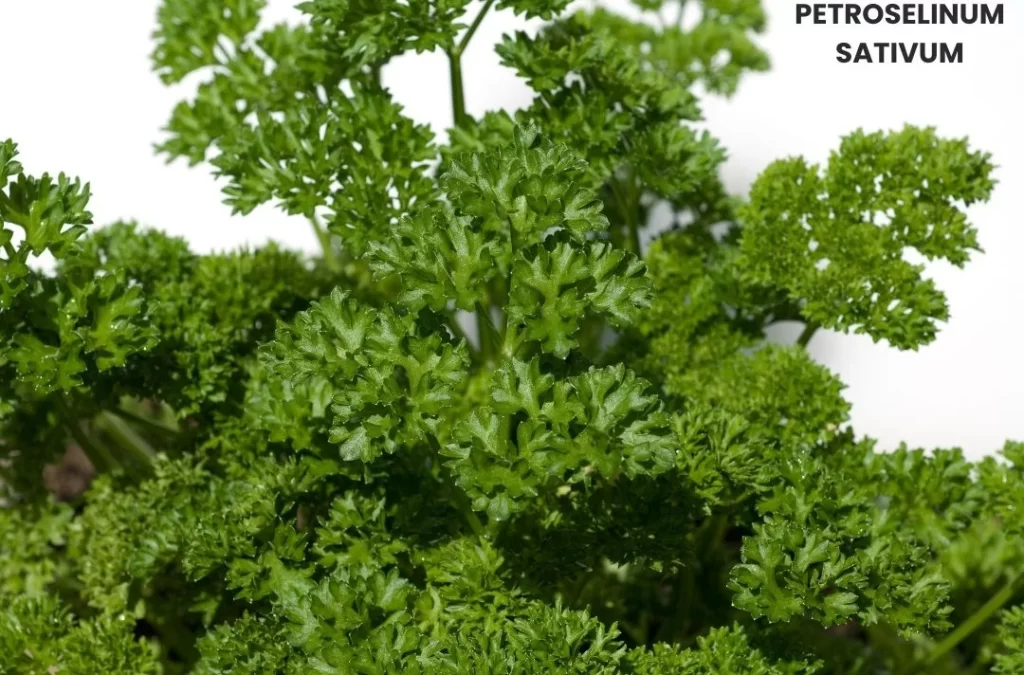Petroselinum Sativum, commonly known as Parsley, is a homeopathic remedy particularly known for its effectiveness in treating urinary symptoms.
Additionally, it is used for conditions like hemorrhoids with significant itching.
Parsley has been utilized in various traditional medicinal systems for its therapeutic properties.

SOURCE INFORMATION
Scientific Classification
- Kingdom: Plantae
- Order: Apiales
- Family: Apiaceae
- Genus: Petroselinum
- Species: Petroselinum crispum
Origin and Historical Facts
- Origin: Parsley is native to the central Mediterranean region but has been naturalized in many parts of the world. It is widely cultivated as an herb, spice, and vegetable.
- Historical Usage: Traditionally, parsley has been used for its diuretic properties, and it has played a role in various folk remedies.
- It was often employed to treat urinary tract infections, kidney stones, and as a general tonic for the urinary system.
- Medicinal Uses: In addition to its culinary uses, parsley has been used in herbal medicine to address issues such as digestive problems, menstrual disorders, and inflammation.
- Its extract, Apiol, has been specifically noted for its use in treating dysmenorrhea (painful menstruation).
DRUG PATHOGENESIS
- Petroselinum Sativum primarily targets the urinary system, providing relief from burning, itching, and tingling sensations throughout the urethra.
- It is also effective in treating symptoms of gonorrhoea and alleviating the intense desire to urinate.
- The remedy addresses the itching and irritation associated with hemorrhoids.
KEY CHARACTERISTICS
- Urinary Symptoms: The hallmark of this remedy is its effectiveness in treating burning and tingling sensations in the urinary tract, sudden urges to urinate, and intense itching in the urethra.
- Hemorrhoids: It provides relief from hemorrhoids with significant itching.
- Appetite Issues: Patients may feel thirsty and hungry but lose their desire to eat or drink once they start.
DETAILED ORGAN SYMPTOMS
URINARY SYSTEM
- Burning and Tingling: Sensations extend from the perineum throughout the whole urethra.
- Sudden Urging to Urinate: Patients experience a sudden, irresistible desire to urinate.
- Itching and Tickling: There is frequent, voluptuous tickling in the fossa navicularis (a part of the male urethra).
- Gonorrhoea: Characterized by an intense biting and itching sensation deep in the urethra, often accompanied by a milky discharge.
STOMACH
- Appetite Issues: Although patients feel thirsty and hungry, they lose the desire to eat or drink as soon as they begin.
MODALITIES
- Worse: Symptoms worsen with the urge to urinate and during urination.
- Better: Symptoms improve with relief from urination.
WHAT ARE MODALITIES IN HOMOEOPATHY?
RELATIONSHIP WITH OTHER DRUGS
Compare
- Apiol: The active principle of parsley, used in treating dysmenorrhea.
- Cantharis (Canth): Effective for severe burning and pain during urination.
- Sarsaparilla (Sars.): Known for treating urinary tract infections and kidney stones.
- Cannabis Sativa (Cannab): Used for urinary tract symptoms, especially with a sensation of fullness and pressure.
- Mercurius (Merc): Addresses various infections and inflammations of the urinary tract.
DOSE
- Potency: Petroselinum Sativum is typically used in the first to third potency, depending on the patient’s symptoms and response to treatment.
- Administration: It is usually taken in homeopathic doses as prescribed by a qualified practitioner.
Frequently Asked Questions
What is Petroselinum Sativum used for?
- Petroselinum Sativum is primarily used to treat urinary symptoms such as burning, tingling, and itching in the urethra.
- It is also effective for hemorrhoids with significant itching and for certain symptoms of gonorrhea.
Is Petroselinum Sativum safe to use?
- When used in recommended homeopathic potencies, Petroselinum Sativum is generally safe for most individuals.
- It is advisable to consult with a qualified homeopathic practitioner for proper dosage and administration.
What are the side effects of Petroselinum Sativum?
- Side effects are rare when used in homeopathic potencies.
- Inappropriate use or overdosing may lead to an aggravation of symptoms.
- Always consult with a homeopathic practitioner for proper guidance.
Glossary of Difficult Words
- Perineum: The area between the anus and the genitals.
- Fossa Navicularis: A part of the male urethra.
- Gonorrhoea: A sexually transmitted infection caused by the bacterium Neisseria gonorrhoeae.
- Dysmenorrhea: Painful menstruation.
- Potency: The strength of a homeopathic remedy, indicated by the number of times it has been diluted and succussed (shaken).
By understanding the detailed drug picture of Petroselinum Sativum, individuals and practitioners can make informed decisions regarding its use in treating urinary and other related conditions.
